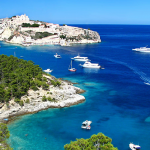
Tran quoc pagoda
Hanoi, the capital city of Viet Nam, has been attracting domestic and foreign tourists for its thousand-year-old history, rich cultural traditions and friendly people. For several consecutive years, Hanoi has been voted by readers of the prestigious US Travel & Leisure Magazine as one of the ten most attractive cities in Asia.
Established in 1010 by King Ly Cong Uan, Hanoi has the greatest number of listed historical sites in the country, with two sites per sq.km on average. Many of them are closely connected with the process of founding and safeguarding the country, such as the Co Loa Citadel, the Soc Son historical site, Van Mieu-Quoc Tu Giam (Temple of Literature) – Viet Nam’s first university which was built in 1070, and the house on stilts where President Ho Chi Minh, who was recognised as a world cultural celebrity by the United Nations Educational, Scientific and Cultural Organisation (UNESCO) in 1990, lived and worked during the last years of his life.
Numerous museums, including the Viet Nam Museum of History, the Viet Nam Revolutionary Museum, the Viet Nam Military Museum and the Viet Nam Museum of Ethnology, offer insights into the nation’s history from its founding days throughout various wars of resistance against foreign aggressors.
The old quarter of Hanoi, with ancient houses and busy streets, is particularly appealing to foreign visitors, as here they can see the pulse of a thriving city.
The city also charms visitors with streets lined with old villas built during the period of French domination in the late 19th century.
The best time to visit Hanoi is possibly October when autumn comes, bringing warm sunlight, a gentle breeze and the streets at night are bathed in the sweet smell of various flowers.
Food is another attraction of the city. Hanoi’s delicious dishes have become well known around the world, such as pho bo (noodle soup with beef), Cha Ca La Vong (La Vong Grilled Fish Pies), Banh Cuon Thanh Tri (Thanh Tri Rolled Rice Pancake), and Gio Cha Uoc Le (Uoc Le Pork Pastes).
In addition, special dishes from all three regions of the country have found their way to Hanoi, and those foreign visitors who miss their home cooking can also find European and Asian dishes in many restaurants and hotels in the city.
Visitors to Hanoi should not miss out water puppetry performances. Viet Nam is compiling a file for this traditional art in order to propose to UNESCO to recognise it as a world cultural heritage.
Handicraft villages around Hanoi are also worth visiting, such as the Ngu Xa village, which is engaged in bronze casting, the Vong village, which makes roasted green rice, and Bat Trang ceramics-making village.
Staying in Hanoi is convenient and comfortable, as the city has 360 hotels with more than 10,000 rooms meeting international standards, 200 domestic and international travel agencies with over 1,000 tourist guides who are fluent in English, Russian, French, Spanish, Japanese and Chinese languages.














Recent Comments